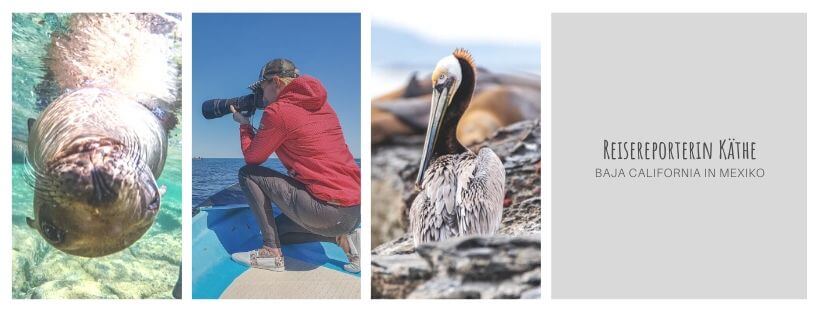Baja California in Mexico. That’s the destination of today’s travel reporter story. Käthe has already thrilled us in the past with her incredible story from Tonga in the South Pacific, and today’s story is guaranteed to be no less exciting. Anyone who knows Käthe knows that she has a great weakness for large marine mammals. In today’s article, Käthe takes us on one of her greatest adventures and tells us about her unique encounter with the giants of the sea. A heartfelt thank you to Käthe for these stories and wonderful pictures. Enjoy reading! If you feel like it at the end, feel free to leave a little love for Käthe in the comments!
- Whale Watching in Baja California
- Cabo San Lucas – Humpback whales ahead
- Todos Santos – Hatching aid for sea turtles
- La Paz – Whale sharks and sea lions
- Puerto San Carlos – Gray whales from Alaska
- Loreto – The giants of the sea
- Important facts and travel tips
Hola! It’s me, Käthe. You may already know me from the report about Tonga and the humpback whales. Since my trip to Hawaii and my first encounter with whales, my fascination with these creatures has known no bounds. From then on, my subsequent trips were based on the whales’ migratory movements. Today I’m taking you to Mexico. More specifically, to the Baja California Peninsula.
Whale Watching in Baja California
Why didn’t I travel here sooner? I asked myself this question after just a few days. This strip of land in western Mexico, below the US state of California, has a great deal to offer in terms of animals and nature, and makes my photographer’s heart beat faster. To the west of the peninsula lies the Pacific Ocean, and to the east the Gulf of California, once called the “Aquarium of the World” by oceanographer Jacques Cousteau.
Anyone, like me, with a weakness for our large marine mammals will get their money’s worth here at just the right time. The reason for my trip was the gray whale migration. The Pacific is the only ocean in the world where whales live. In December, they travel from Alaska to the warm lagoons of Baja to give birth to their calves after more than a year of gestation and to reproduce.
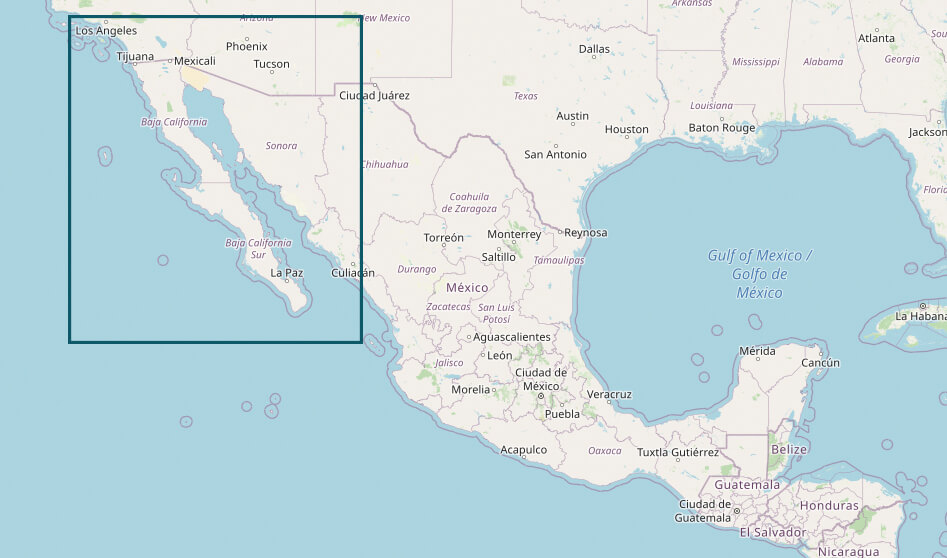
From January to March, you have the opportunity to observe cows with their calves. For some inexplicable reason, the whales, especially the young calves, are very trusting here. They come right up to the boat and even let you pet them. I absolutely had to experience that up close. You can also encounter the largest mammal on our planet: the blue whale.
While we’re on the subject of big boys, why not pay a visit to the biggest fish, the whale shark? The friendly humpback whales also like to frolic around the coasts of Baja. Then there are the funny, playful sea lions. And you can never get enough of sea turtles. No question about it! Baja California is the perfect destination for nature and animal lovers. But let’s start from the beginning…
Cabo San Lucas – Humpback Whales Ahead
We start our journey in Cabo San Lucas, at the southernmost point of the peninsula. The international airport in San Jose del Cabo is not far from here. Cabo San Lucas is a famous “party destination” for US Americans. That’s why we won’t stay here long. The reason for our visit is the humpback whales around El Arco de los Cabos, the symbol of the Los Cabos region.
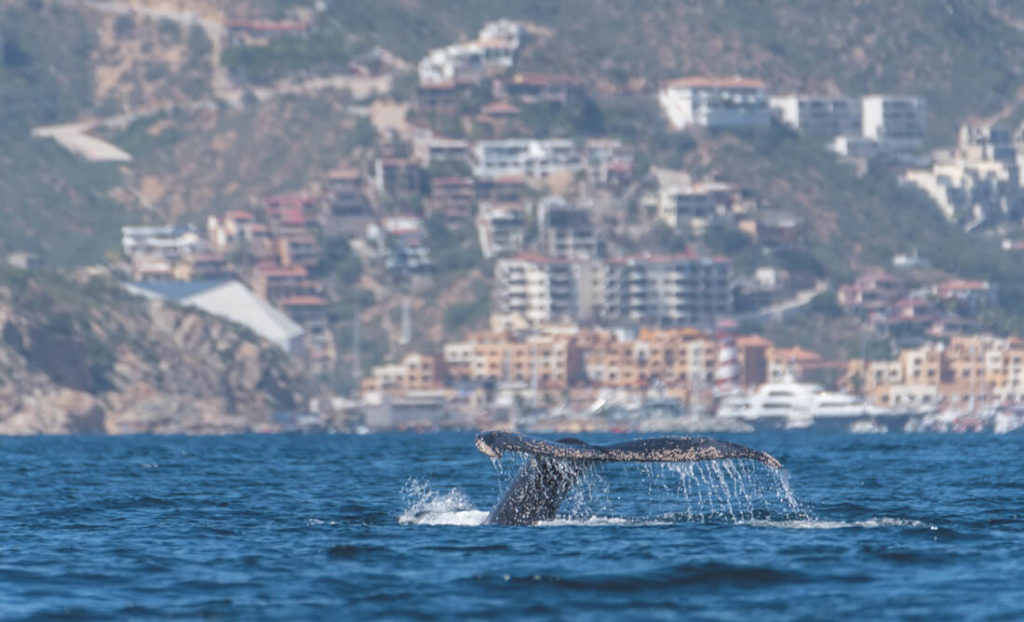
A characteristic rock formation with a sea lion colony and good snorkeling spots. In the morning, we take a three-hour whale-watching tour on a small Zodiac boat. The smaller the whale-watching boats, the better the experience. We already learned that in Hawaii. We see some humpback whales before continuing on to Todos Santos.
Todos Santos – Hatching Assistance for Sea Turtles
Here, at sunset, a long-held dream is about to come true. I love sea turtles and have long wanted to see them come to the beach to lay their eggs, or even more so, see them hatch and fight their way out to sea. The small aid organization “Tortugueros Las Playitas” fights for the protection of turtles and the preservation of their habitats. During the egg-laying season from October to December, they collect the nests on the beach and relocate them in a kind of greenhouse that serves as an incubator.
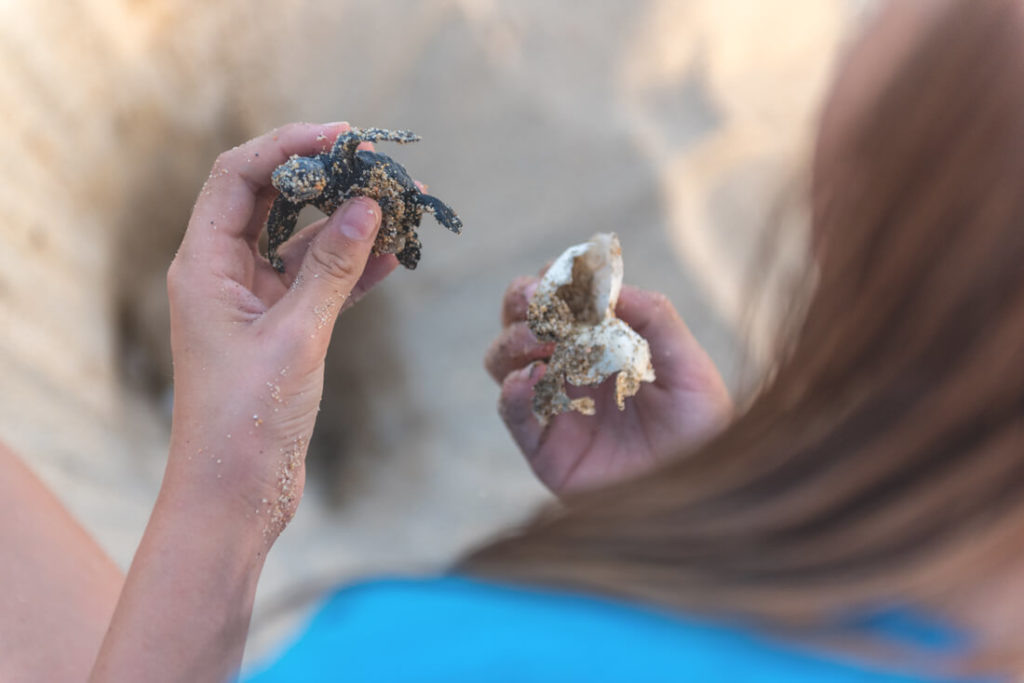
The eggs lie here protected and at a constant temperature in the sand for about two months. From January to the beginning of March, newly hatched baby turtles can be released into the sea at sunset. Three species of sea turtles nest on these beaches: the Olive Ridley, the Leatherback, and the Pacific Black Turtle. About every two to three years, female turtles come ashore to lay their eggs. They always seek out the same beach where they hatched, crossing entire oceans to do so.
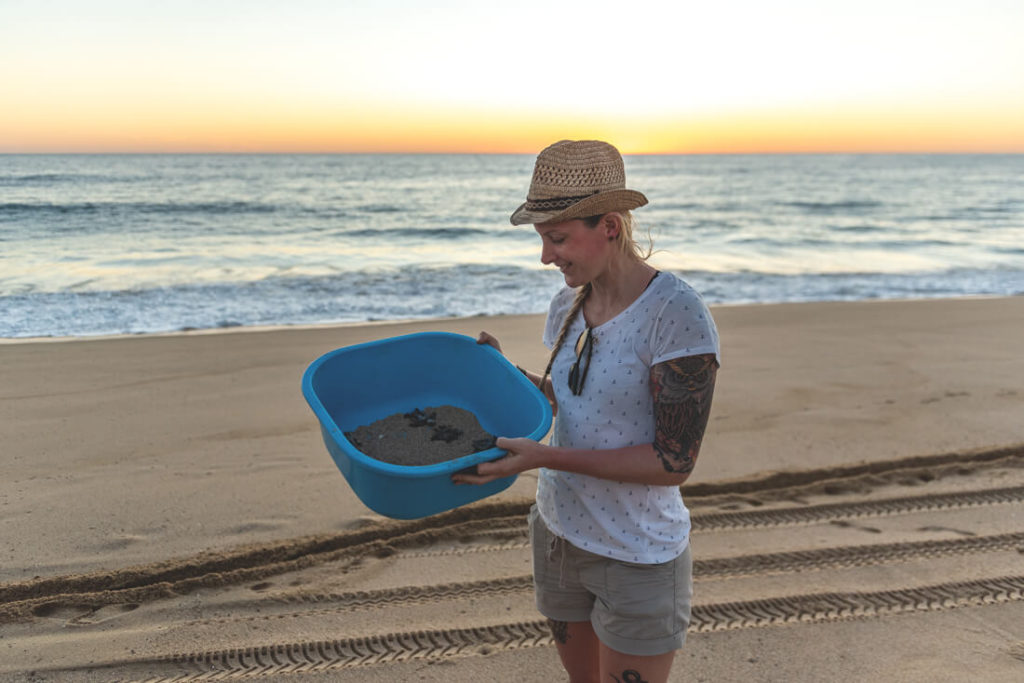
The Path to Nature
We were lucky. Several Olive Ridleys had just hatched when we arrived. Depending on the species, approximately 200 eggs are laid in a nest. Statistically, only one in 1,000 baby turtles will survive to adulthood. A pretty poor rate. Here, they are assisted during the hatching process. In the wild, many already fail to emerge from their eggs and reach the surface. The organization’s goal is to release as many healthy babies as possible into the wild. After that, however, they are on their own.
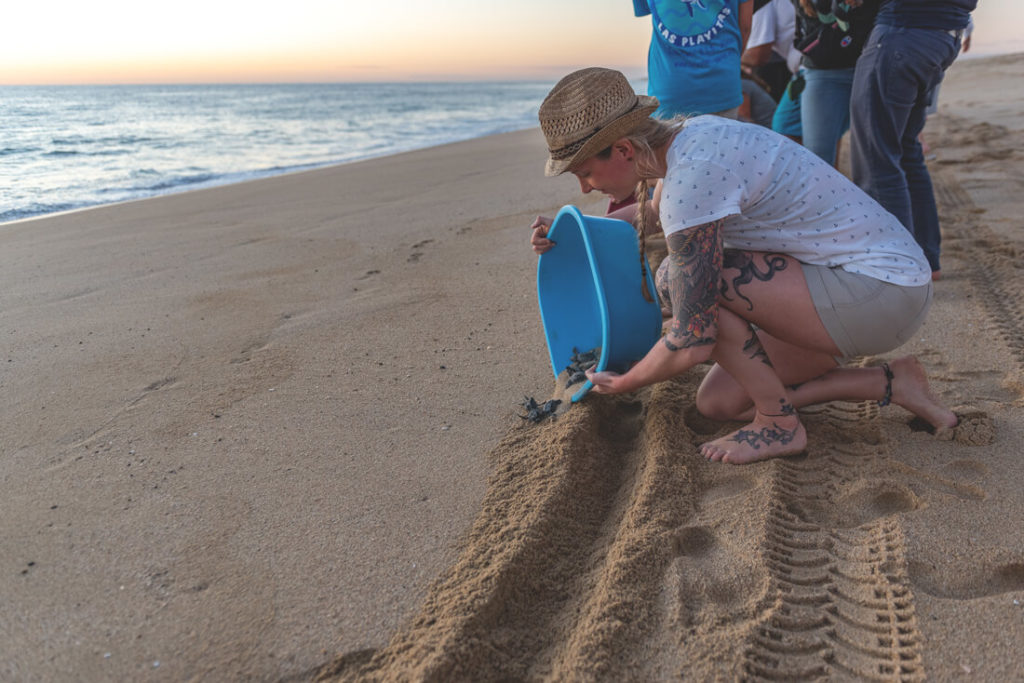
The sun is gradually setting into the sea. Anyone who wants to can take a plastic bowl filled with baby turtles and carry it to the beach. There, they are carefully placed in the sand. Tourists are strictly forbidden to touch them. Now you can watch the little ones fight their way to the sea until nightfall. Again and again, they are carried back and knocked over by the waves.
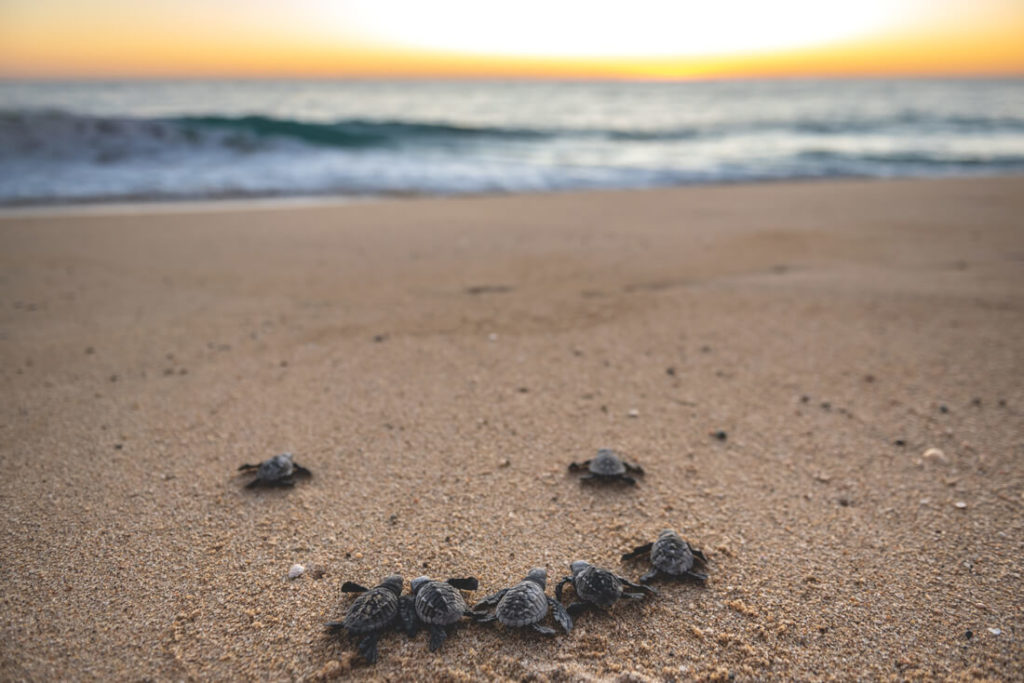
Here, too, many are lost in the wild because they are a feast for seabirds. I hope that many of our little charges survive and have a wonderful life ahead of them as turtles. Before we continue on to La Paz the next day, we visit the “Pueblo Magico” (the Magical Village) of Todos Santos. A pretty, colorful little town with colonial buildings, cafés, and art galleries. Definitely worth a short stroll.
La Paz – Whale Sharks and Sea Lions
La Paz is the charmingly relaxed capital of Baja. The absolute highlight here is a boat trip to the offshore island of Espiritu Santo. Small, uninhabited, and of volcanic origin, here you can get up close and personal with the sea lions. They live in colonies on the volcanic rocks. Snorkeling around the rocks allows you to get very close to these particularly curious young animals. Like small torpedoes, they shoot through the water and perform graceful dances. The snorkelers are constantly challenged to play. The alpha sea lion dad always makes sure that no one gets too close.
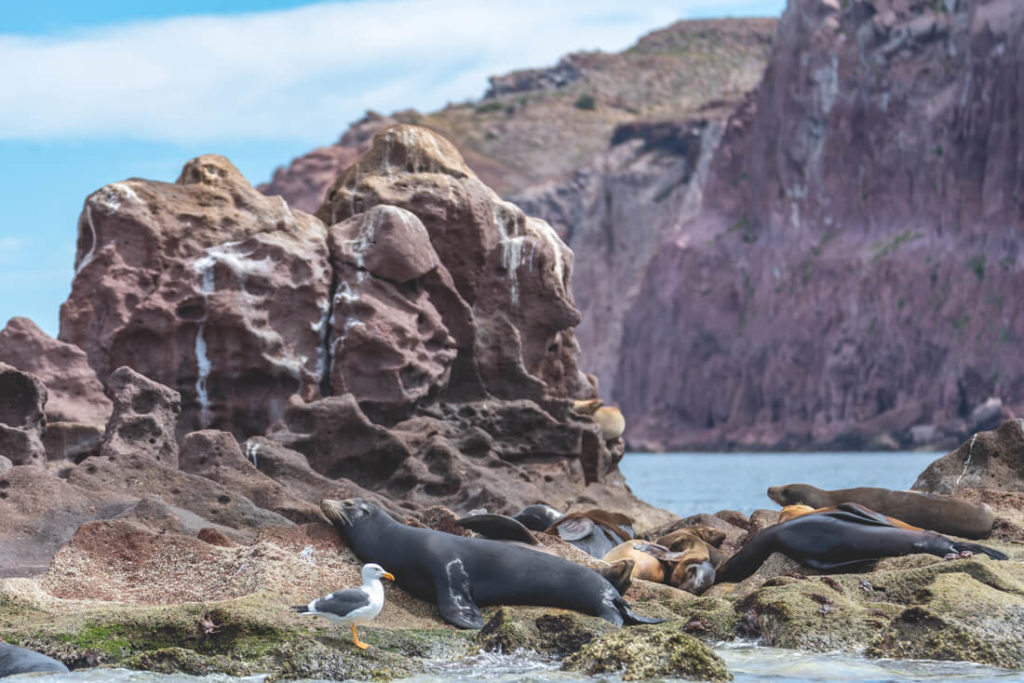
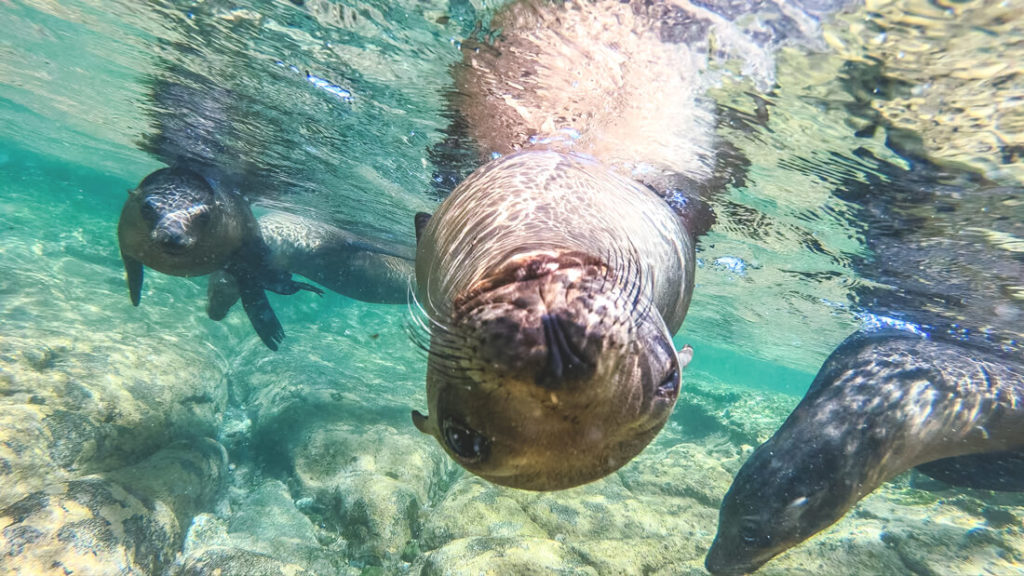
Not far from this island is a large marine reserve. Whale sharks live here, and at up to 14 meters, they are the largest fish alive today. These giants glide leisurely through the water in search of plankton. They are unfazed by an adventurous snorkeler. La Paz is also home to what is said to be the most beautiful beach in Baja. Balandra Beach is a wonderful circular path that offers stunning views of the bay. On a guided street art tour we learn a lot about the history and culture of La Paz.
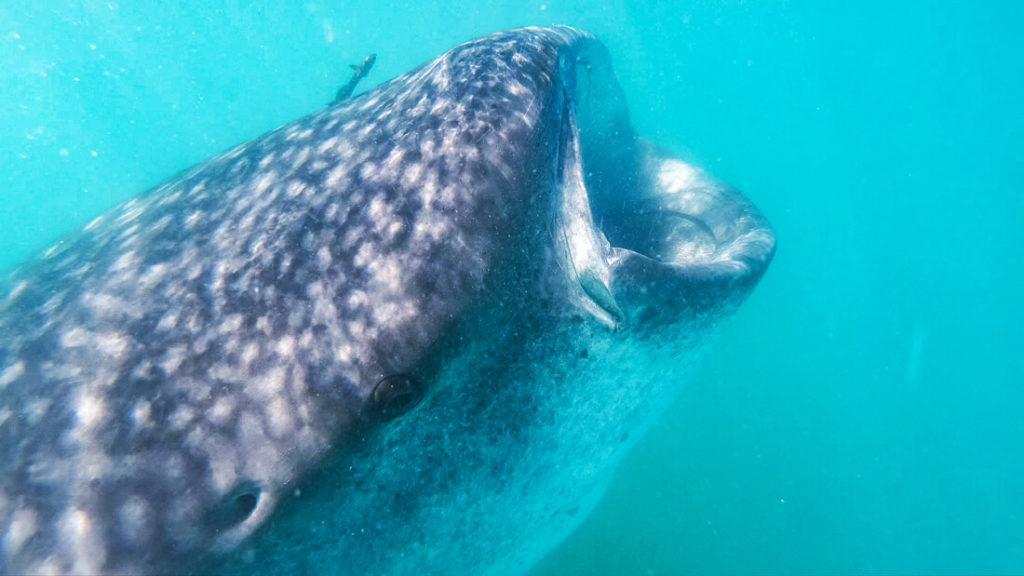
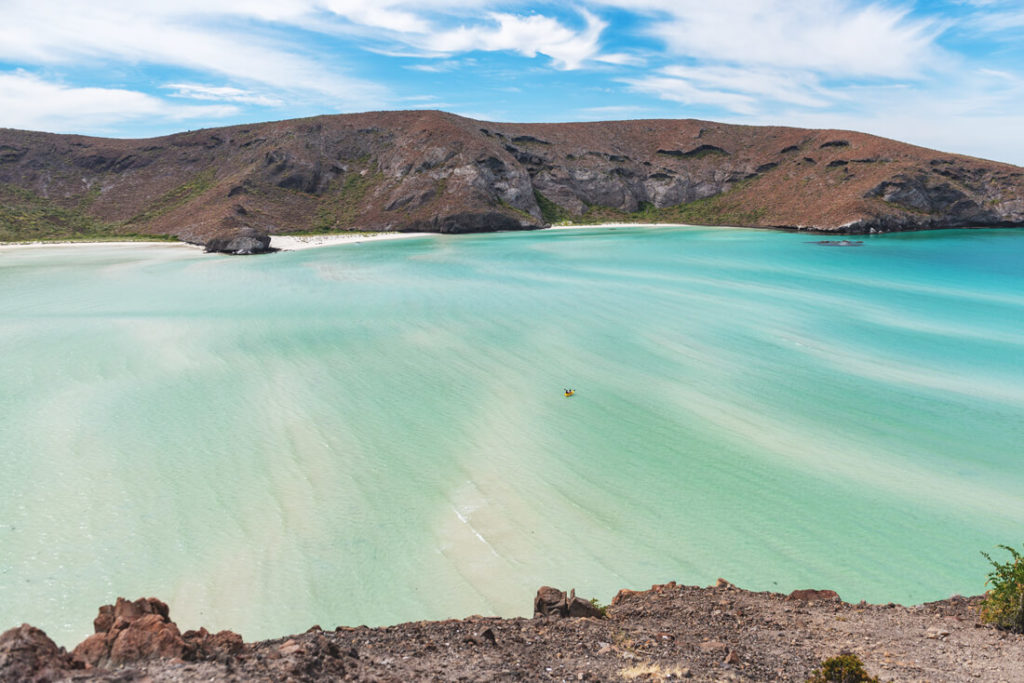
Puerto San Carlos – Gray Whales from Alaska
We continue north to the Pacific coast. In the small fishing village of Puerto San Carlos on Magdalena Bay, you can join fishermen in traditional wooden boats (called pangas) out into one of the three whale bays. This is also possible further north in San Ignacio Bay and Guerro Negro Bay. Gray whales from Alaska come here every year to calve in the warm, protected bays. There are only a few hotels and whale watching operators in this small, somewhat remote town. For the next two days, we will explore the gray whales with Magdalena Bay Whales. We will be looked after by their family-run Hotel Isabela and enjoy a wonderful breakfast buffet on our first morning. Rested and full of excitement, our boat guide will pick us up from the harbor early in the morning, along with our panga. It can accommodate up to 8 people. We’re lucky and are sharing the boat today with just two other people plus the boatman. These pangas are very small and very close to the water’s surface. I realize how close the encounter with the gray whales will be if they show interest in our boat, and I can hardly wait for it with joy and excitement.
Water fountains in Magdalena Bay
So we head out into Magdalena Bay, and after just over half an hour, we see several water fountains shooting into the air from afar. The blow, the whales’ breathing, always reliably reveals where whales are, even from a distance. The boatman steers straight towards them. Suddenly we’re in the middle of it all. Fountains everywhere, loud hissing, sometimes close, sometimes far away, whale flukes… whale flukes everywhere. I don’t even know where to look or point my camera.
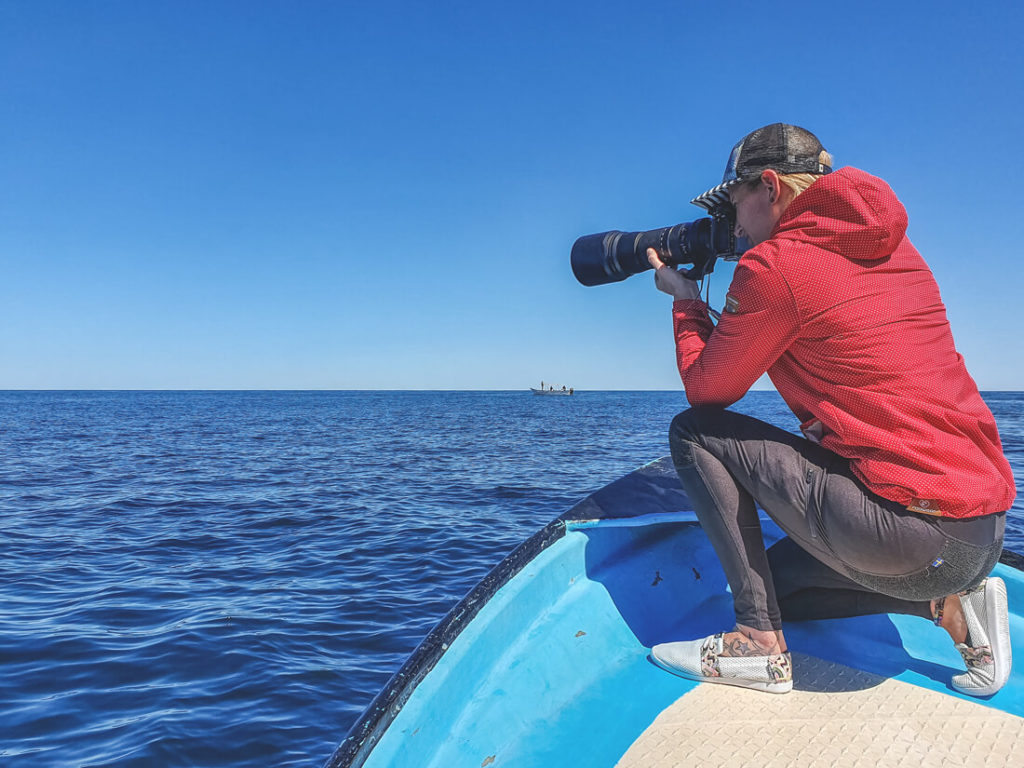
The whales, up to 15 meters long, swim directly under our boat. All you can see is a bright shimmer in the water. If they wanted to, they could capsize our boat. But they know we come with peaceful intentions. That wasn’t always the case. In the days of whaling, whalers also called the gray whale “devilfish.” This was due to the aggressive attacks of female whales trying to protect their calves. The small pangas shattered under the powerful fluke blows.
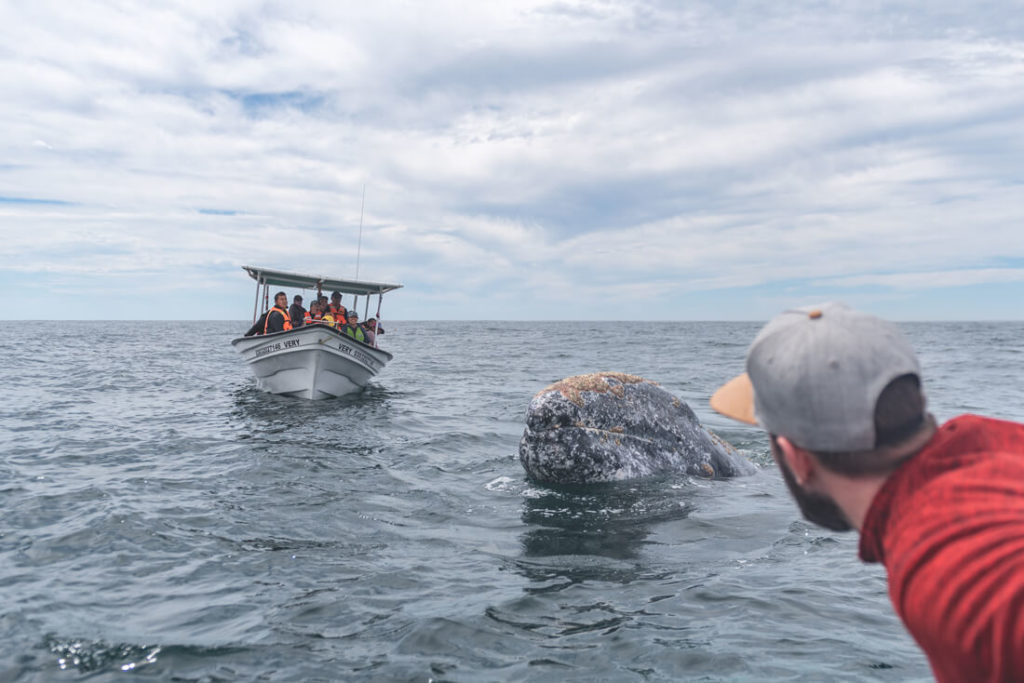
Again and again, a whale curiously approaches the boat, just a few centimeters from us, right at the water’s surface. They surface between the pangas to catch a glimpse of us. Who’s actually watching whom here? Are we watching the whales, or vice versa? I already mentioned it in my report on Tonga. A look into the eye of a whale is something very special. I always feel like the whole world is in their eyes. So gentle and strong, so peaceful and loving. Here in Magdalena Bay, I even managed to look a gray whale straight in the eye. It’s simply indescribable.
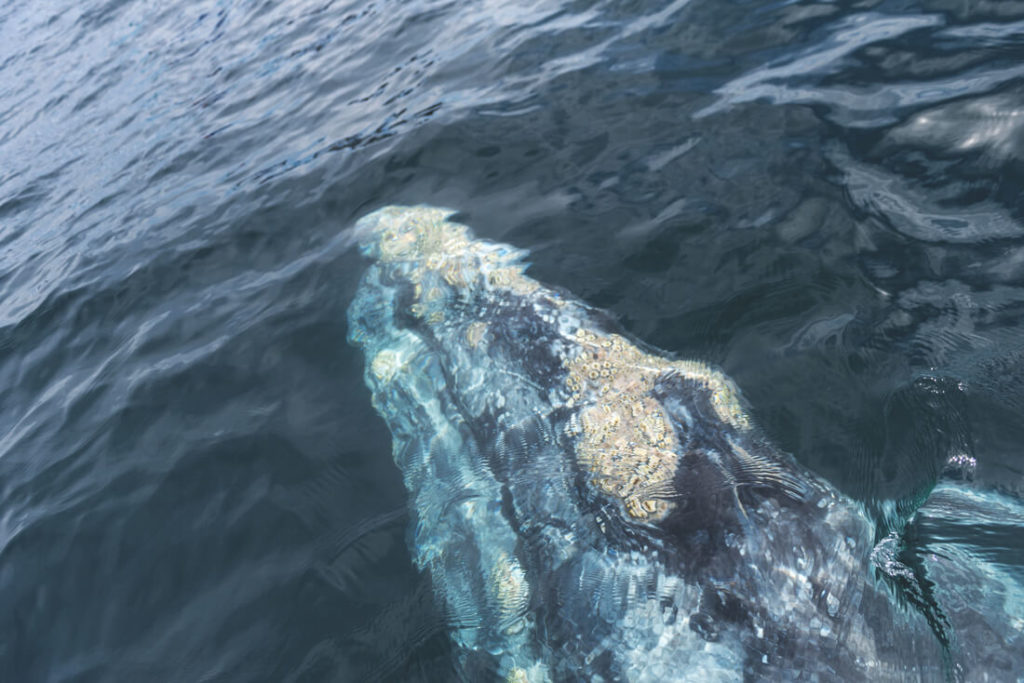
Day 2 with the Gray Whales
On day two, the whales didn’t seem as active. The sky was heavily overcast, and we sailed for hours in our boat through the bay. Almost disappointed, our boatman then received a secret radio message from a colleague. With everything his panga could muster, we set off. After a few minutes, we spot a single panga surrounded by two whales. They curiously poke their heads out of the water again and again and even allow us to pet them. They swim under the boat and playfully nudge it from below.
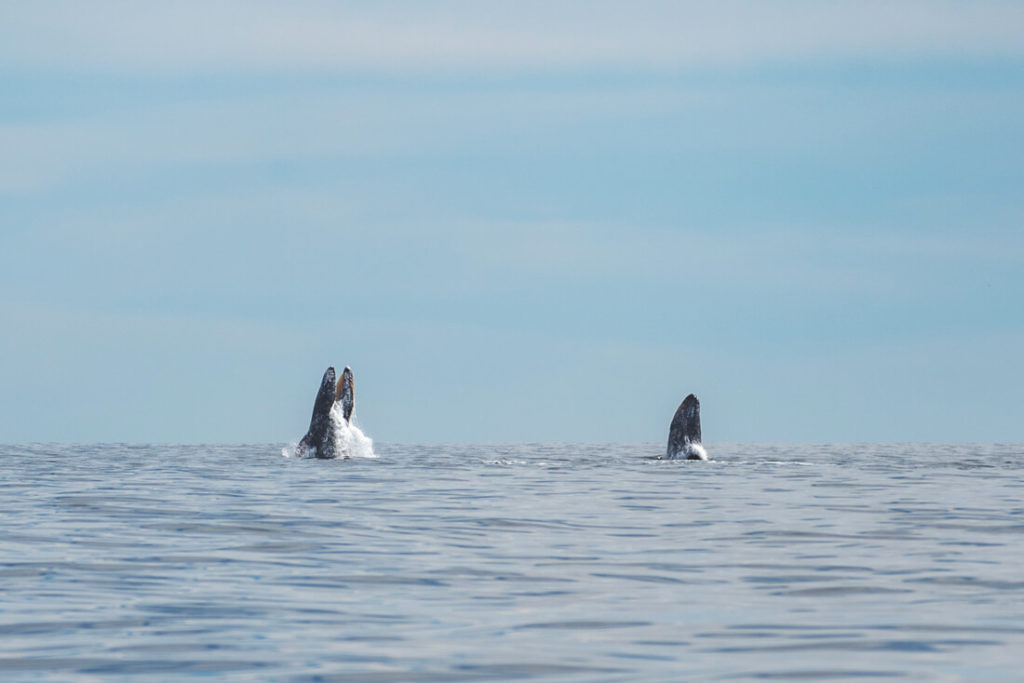
The occupants hop and burst into laughter. This only encourages the whales further. They find it very amusing and repeatedly switch between the two boats. Our boat is also nudged several times. With a full memory card, countless pictures, and wonderful memories, we leave Magdalena Bay after two wonderful days with the gray whales.
Loreto – The Giants of the Sea
We return to the east side of the peninsula and head for the final destination of our trip: Loreto on the Gulf of California. On the way there, we cross the Sierra Giganta mountains, arguably the most beautiful region of Baja California. The golden glow of the setting sun bathes the desert landscape with its countless cacti in beautiful light. The very next morning, we signed up for a boat tour to see the blue whales.

From December to March, they are located in Loreto Bay. Who wouldn’t want to encounter the largest mammal ever to live on Earth? We set out on the boat early in the morning. Upon arriving at the marine reserve, the captain turns off the boat’s engine. We listen quietly to the sound of the ocean. We see several humpback whales before an unmistakably loud hiss announces the first blue whale.
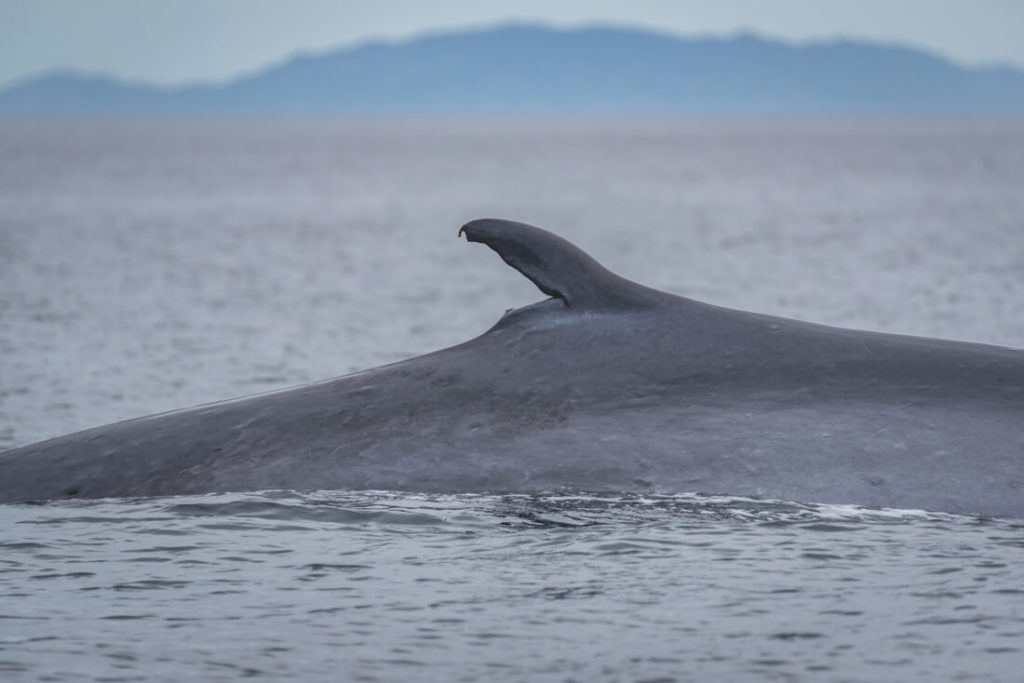
These giants can grow to 33 meters long and weigh 200 tons. That’s equivalent to the weight of about 30 adult African bull elephants. The heart of a blue whale is as big as a Volkswagen Beetle. To meet its massive calorie needs (480,000 calories per day), it consumes up to 4 tons of krill daily. Blue whale babies are already 8 meters long at birth and weigh 3 tons. To grow as big and strong as their mother, they drink 300 liters of milk…a day.
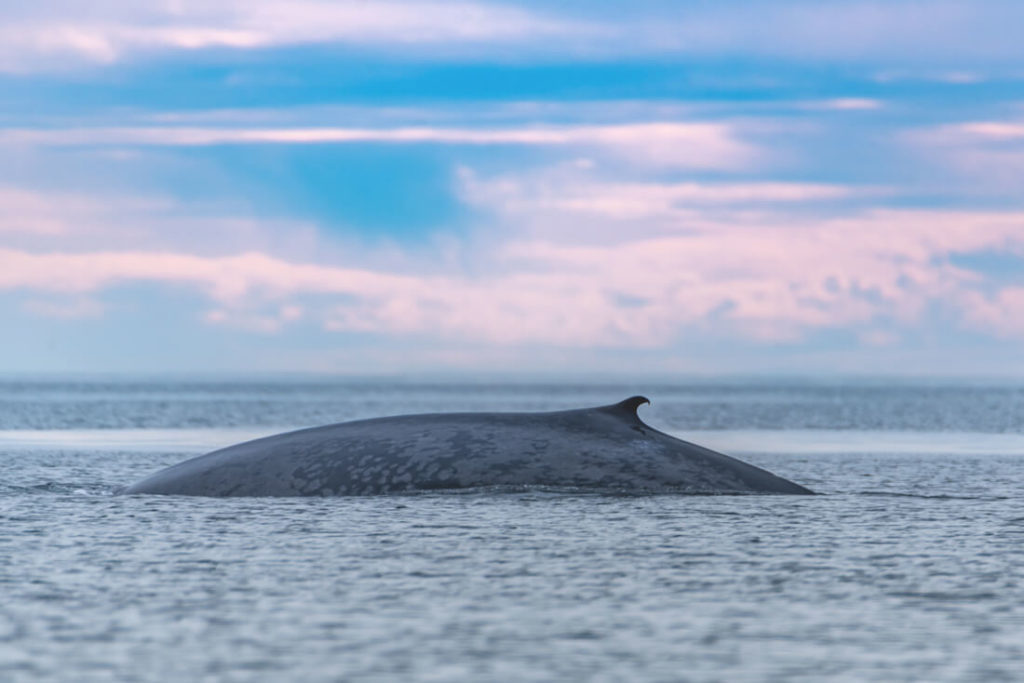
More Highlights in Loreto
Another highlight in Loreto is island hopping in the Parque Maritimo Nacional Bahia de Loreto. We decide to take a boat trip to Isla Coronado. A small, uninhabited island consisting of impressively shaped rocks of volcanic origin. Here, too, lives a playful colony of sea lions with whom we can snorkel. We also encounter various seabirds such as pelicans and the famous blue-footed booby.
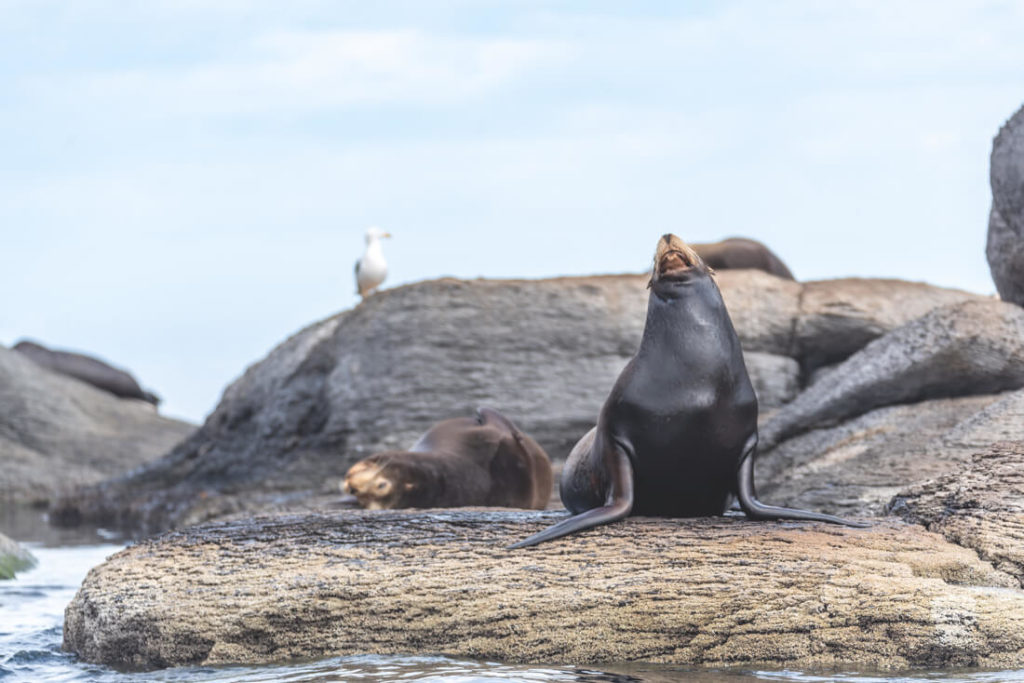
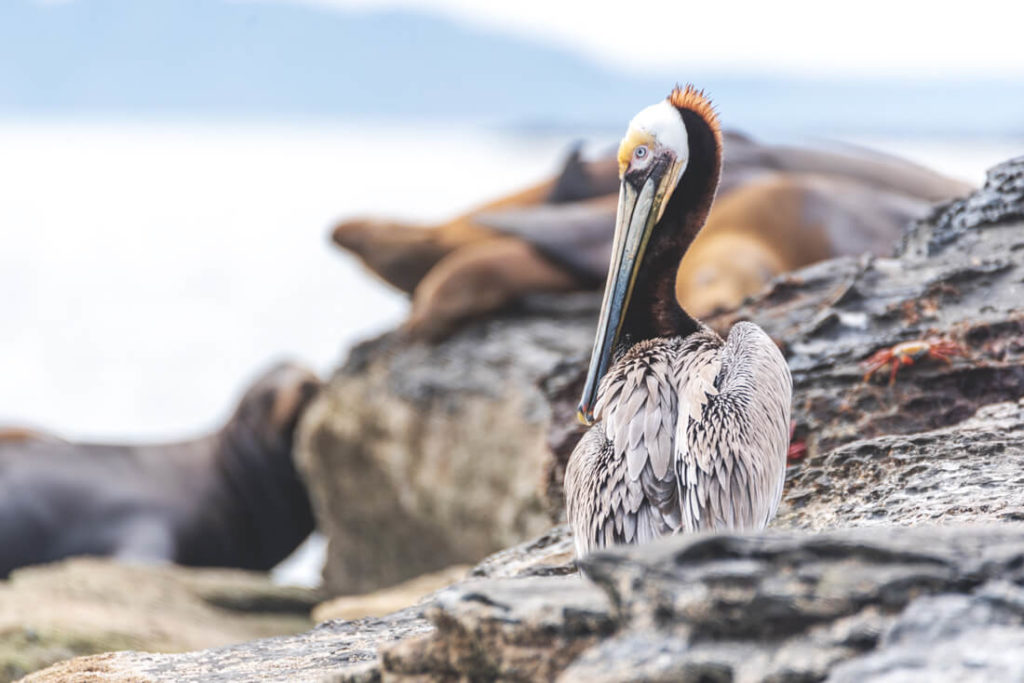
But Loreto also has a lot to offer on land. To feel solid ground beneath our feet again, we take a hike into Tabor Canyon. We scramble over the eroded rocks and see several hummingbirds busy building their nests. Here, too, we see small cave paintings, although they are much better preserved in the north of the peninsula. Unfortunately, we don’t have enough time to explore this one. We head south again to San Jose del Cabo and look back on an eventful, nature-filled trip that more than met all our expectations.


Important Facts and Travel Tips
The best way to explore the 1200 km long peninsula is on a road trip. You can book a rental car* in advance and pick it up directly at the airport. The peninsula is divided into Baja California Norte and Baja California Sur. While Baja California Sur boasts vast cactus deserts, mountain and vineyard landscapes, and prehistoric cave paintings, Baja California Sur boasts beautiful beaches and, as described above, all kinds of wildlife.
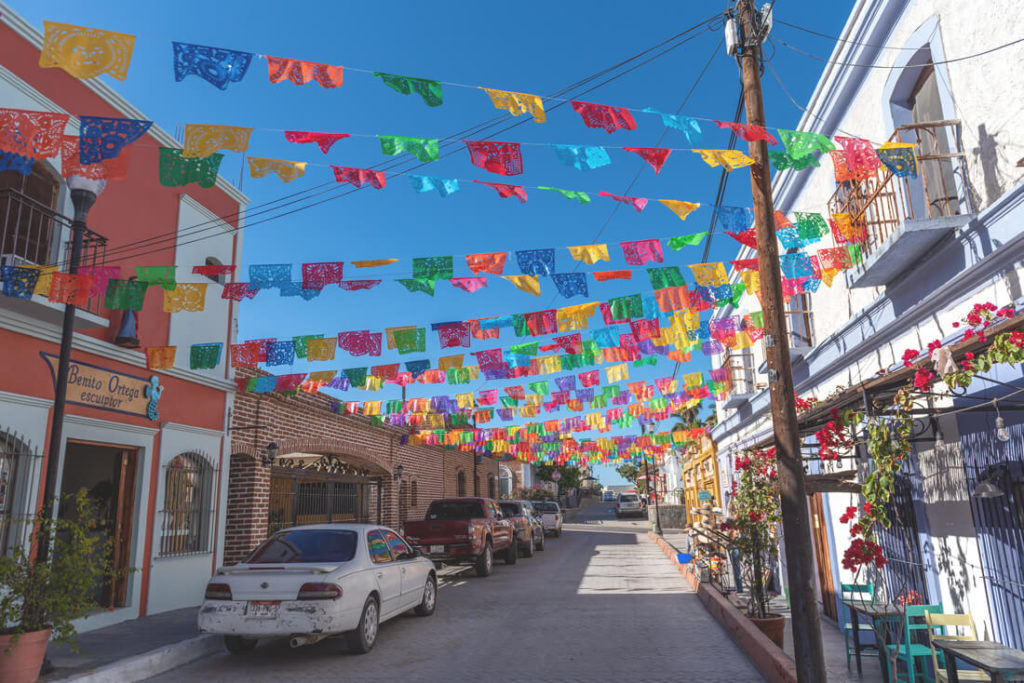
If you have enough time, you can drive the entire Mex1 from Tijuana to San Jose del Cabo or vice versa. You should plan at least three weeks for this. Most visitors to Baja fly to San Jose del Cabo in the very south and drive to the gray whale bays, stopping off along the way. This was also our itinerary for 12 days in Baja California.
Since the one-way fee for the rental car was quite expensive, we decided to drive the whole way back. This also made the flights much cheaper. Most flights to and from Germany go via the USA. The best time to travel for whale watching is from January to March. It’s said that the calves are especially playful and curious in February.
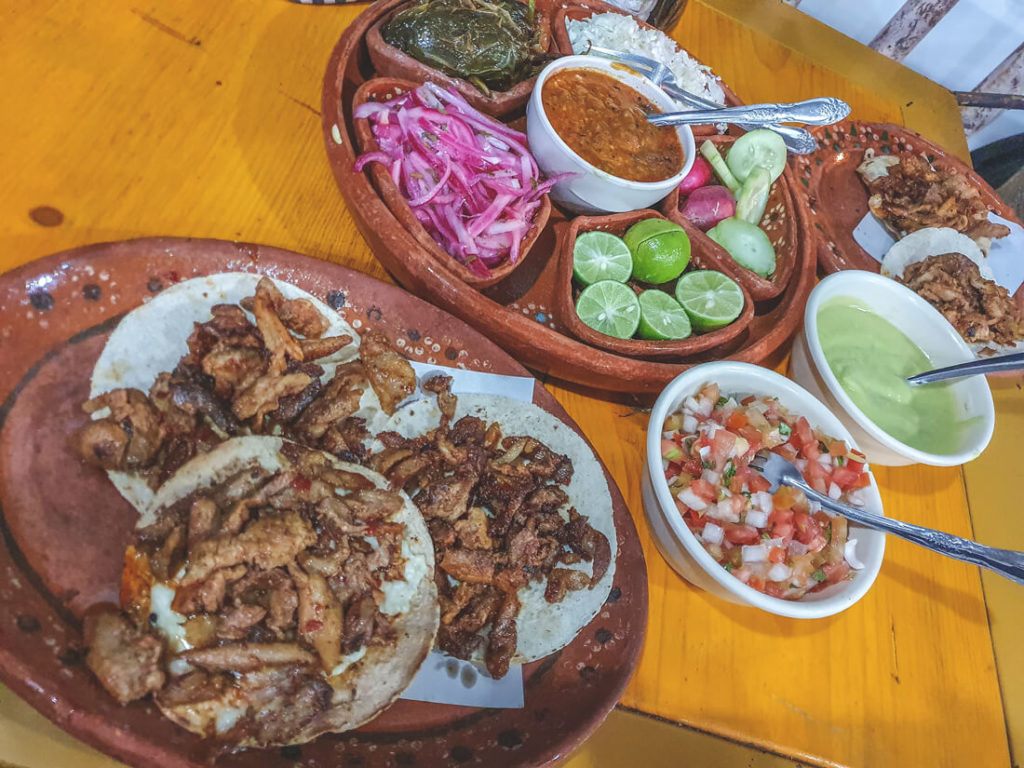
Accommodation can be found both on Booking.com* and on AirBnB*. For €40 to €50 per night for two people, you’re already in the running. There are even some great glamping and camping options on AirBnB. Food is quite affordable in Mexico. There are delicious tacos and burritos everywhere, which are a reason alone to travel.
